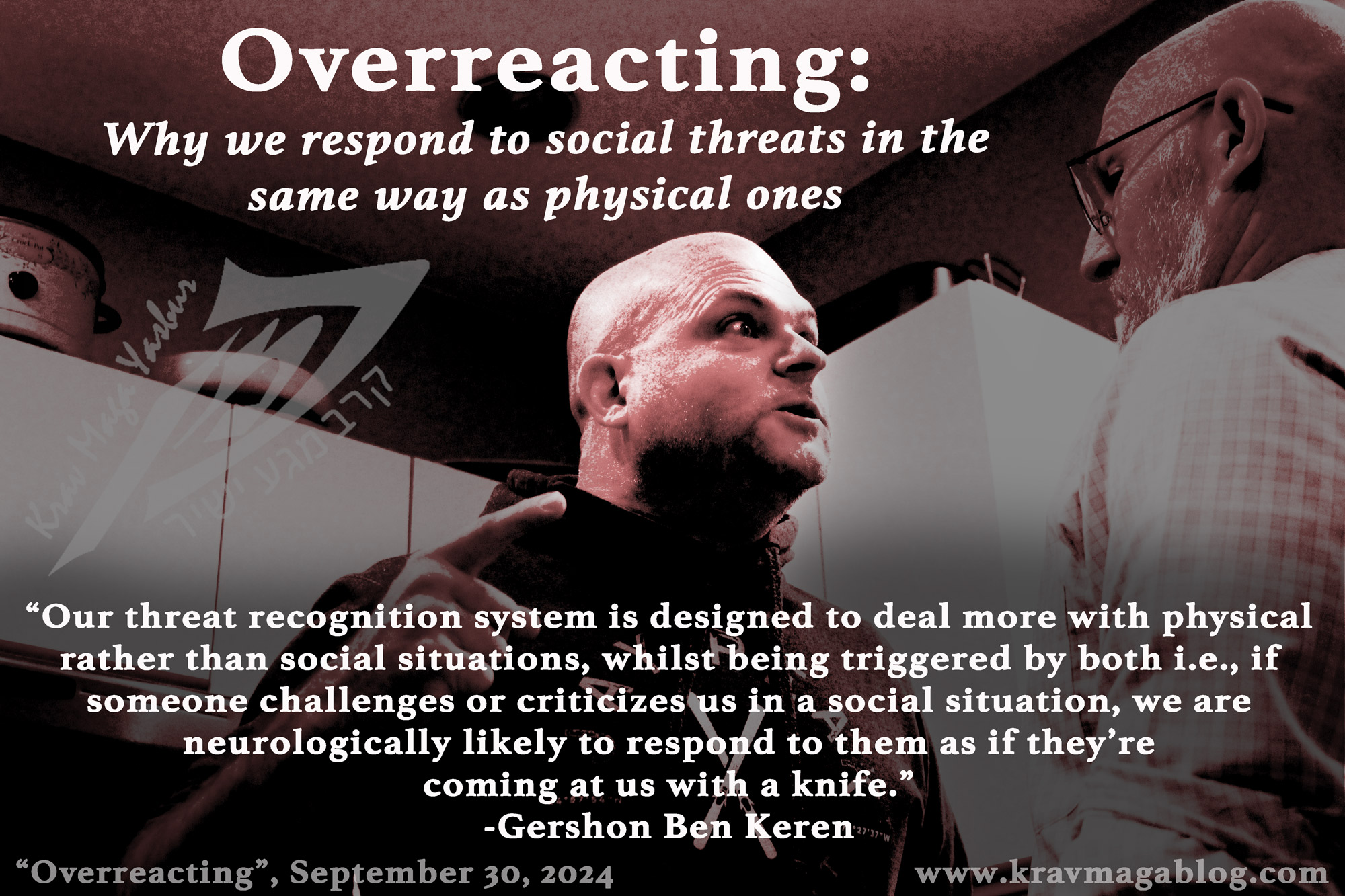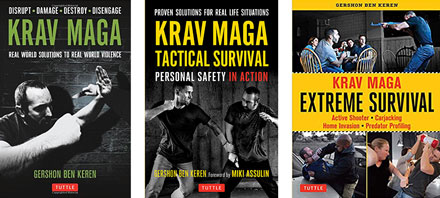Overreacting: Why we respond to social threats in the same way as physical ones

Most aggressive and potentially violent incidents are the result of bad social interactions. These can be with strangers, but they can also involve friends and family members; sometimes these incidents can see us become angry faster and more quickly because we a) feel safe responding to people we know in this way i.e., we don’t expect them to punch us, whilst with a stranger we have no idea how they might respond to our angry outburst, and b) these are the individuals who we feel should be supportive, non-critical and non-challenging/non-threatening to us etc. There is also an inherent danger in basing how we believe a stranger might react on our experiences with people we know e.g., if most of our angry outbursts/reactions have been towards friends and family members where the consequences have been minimal we may be conditioned to believe that if we react/respond to strangers in the same way, we will experience similar outcomes, which may not be the case. Just because a friend or family member will put up with us talking to them in a certain way when we are angry doesn’t mean that a stranger will. Learning how to control our emotional responses to those we know can help us manage our reactions when we feel threatened or challenged by strangers in public rather than private settings. We should be able to successfully handle all bad social interactions regardless of our relationship to the person we are dealing with; something that is much easier said than done, especially when we have developed “rituals” involving those that we know, in order to give us a safe way out e.g., there is a reason why arguments between couples normally come back to unrelated and common themes; they are familiar and safe, whilst to continue with a “new” dispute would mean entering the unknown. By understanding how we react to threats/challenges, whether from friends, family members and/or strangers, we can help manage our responses to them.
Anger is a reaction, and it can be justified. If someone criticizes, misjudges us, and/or accuses us wrongly, it is likely that we will react defensively, which often involves anger. The problem with anger is that it has a sense of urgency to it. It requires that we act in the moment. This is how we are hard-wired to work. When we find ourselves in an emotionally heightened state, it is not for us to make long-term decisions that will positively affect us some time down the road, but rather to make an immediate response to whatever it is we are facing in that moment. Simply recognizing and understanding this should help us make better responses when we find ourselves in such a state. Many people believe that their moral and emotional state reflects their legal rights, however this is not the case. Just because a perceived injustice has been committed it doesn’t mean that any action motivated from this belief/understanding is legal – I have had to have several conversations during active shooter/killer trainings, concerning the “imminence” of danger i.e., after a shooter/killer has been subdued/controlled and is no longer a threat the right to use lethal force against them is removed, regardless of what their intent initially was or is. Emotionally, in that moment, it is understandable that a person may want to seek justice and eradicate a “threat” that moments before was looking to take their life, however if that individual is no longer a threat the right to do so goes. Anger is not about the long-term, whereas the criminal justice system is. What may feel good and right in the moment may have negative long-term consequences. Equally, an emotional outburst against a friend or family member may feel – and be - justified in the moment and yet negatively affect the relationship going forward. Anger can overwhelm our cognitive processes including good judgment because it is about the “now” and not the future, which is why we often regret and feel shameful of our actions/behaviors when we respond emotionally.
Our threat recognition system is designed to deal more with physical rather than social situations, whilst being triggered by both i.e., if someone challenges or criticizes us in a social situation, we are neurologically likely to respond to them as if they’re coming at us with a knife. That’s just how we work and operate. This is why we sometimes have to deal with people who seem to overreact to things which we see or deem to be minor e.g., why is that person screaming and shouting at us, because we stepped in front of them in a queue/line, took what they believed to be their parking space etc. When I used to work in pubs and bars in the UK, one of the most common forms of aggression that could escalate quickly, was when someone believed that they were entitled to be served before somebody else/out of turn. This “minor”, often misunderstood, inadvertent social challenge, was interpreted as if the other person had just ridden into their village and informed them that they were going to burn down their house and kill all their family members i.e., they and their loved ones were in immediate physical peril. Unlike many other social creatures, we lack rituals and mechanisms to deal with these types of conflict e.g., dogs and wolves when they get into disputes engage in performances of “posturing” which can recognize a “submissive” response, such as rolling onto the back and licking the other one’s nose – job done, crisis/disaster averted. This is why seemingly innocuous social interactions which have gone bad can turn physical.
Whilst we can’t control other people’s reactions we are in control of our own, and the solution is one that we were taught as kids but rarely apply as adults i.e., count to ten before responding. A study of a police department found that the unusually high levels of violence complaints against it came from one type of incident; this was after an officer involved in a foot chase managed to apprehend the suspect they’d been chasing. Out of breath, exhausted, adrenalized and angry that an individual had failed to respond to an order to stop etc., officers would sometimes use excessive force in dealing with a suspect who was now compliant. A consultant solved/reduced the issue by having the officers count to ten after apprehending someone. Understanding that our initial reaction to any threat/challenge, whether it is physical or social, is neurologically the same, should help us to take five or ten, rather than defaulting to our initial response of anger.
 If you enjoyed reading this article you may be interested to read Gershon Ben
Keren's Books (Click on images to go to his Amazon Author's Page). Or If you live in Boston or a surrounding city etc. you may want to sign up for a beginner class,
using the button below.
If you enjoyed reading this article you may be interested to read Gershon Ben
Keren's Books (Click on images to go to his Amazon Author's Page). Or If you live in Boston or a surrounding city etc. you may want to sign up for a beginner class,
using the button below.
Beginner Classes